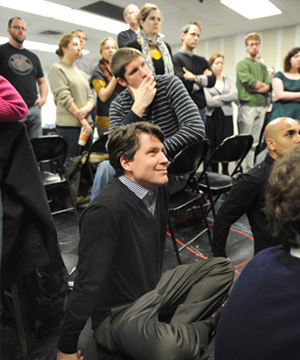Aesthetic competition
Larry Norman revisits a 17th-century intellectual rift over artís evolution toward a more perfect state.
By Brooke E. OíNeill, AMí04
Photography by Dan Dry
“It’s fabulous that you’re off book,” says Court Theatre artistic director Charles Newell to two female actors as they take the stage one cold February morning. Shoes removed to protect the floor of the Bartlett gym rehearsal space, they prepare to perform a scene in Tony Kushner’s tragicomedy The Illusion. A play-within-a-play adapted from French playwright Pierre Corneille’s Baroque-era masterpiece L’Illusion Comique, the material has long challenged audiences and professional thespians alike by blurring reality and fantasy.

As part of their class, Larry Norman and his students sit in on a Court Theatre rehearsal of The Illusion.
Neither of the performers, fourth-years Tory Thompson and Laura Burgos, are professionals, which makes the dialogue between a lovesick daughter and her stern father an especially demanding exercise. Does that ellipsis in the text mean the speaker is being interrupted or trailing off in thought? What sort of emotional change does the word “but” signal? How do other punctuation marks in the text give an actor character clues?
“There are a lot of things students don’t really understand until they have to get up and act it out,” says Larry Norman, associate professor of French literature and theater and performance studies, and the University’s deputy provost for the arts. Today’s short performance is a component of his winter-quarter course Theatrical Illusion: Corneille, Kushner, and the Baroque. Designed to give undergraduates and graduate students an insider’s look at adapting 17th-century drama for the modern stage, the class is a “smorgasbord of Baroque extravagancies,” says Norman. Part literary analysis, part scene study, it also includes hands-on critiques from special guests like Newell, director of Court’s March–April production of The Illusion.
Theater is “the most social art,” says Norman, who specializes in 17th- and 18th-century French literature, theater, and cultural history. “It’s the art in which the interaction of humans is still the most pregnant and powerful.”
He’s spent much of his career studying those interactions, whether between actors onstage or between playwrights and their audience. His French-literature dissertation at Columbia explored how Molière used satire as a “public mirror” to engage—and enrage—17th-century theatergoers, frequently confronting them with a scathing portrait of themselves. Often criticized by his contemporaries for mixing drama and comedy, Molière challenged his audience to reflect on what it meant to laugh at the unfair, often cruel treatment of characters onstage.
In a forthcoming book, The Shock of the Ancient (University of Chicago Press), Norman explores art’s influence by focusing on one 17th-century intellectual rift over aesthetics. It erupted in Paris’s Académie française, a government body that even today oversees uses of the French language. From there the rift spilled into the cultivated reading class. Known as the Quarrel of the Ancients and the Moderns—one of many public literary controversies of the day—it marked the start of a new philosophy of aesthetics. Played out in conversational texts often infused with wit and satire, the quarrel, says Norman, pushed the educated public to “think abstractly about what the arts are and what they do to us.”
At the crux of the argument was the question of whether the arts naturally evolved toward a more perfect state. On one side was the Modern party, insisting that art became more logical, pure, and “morally sophisticated” over time, as more rigid rules of form developed. They denounced classical Greek and Roman works like Homer’s Iliad, Norman writes, protesting “the selfish brutality and sexual immorality of their heroes, lovers, and leaders,” which the Moderns saw as crude and primitive.
The Ancients, on the other hand, believed such works were timeless. Even if a Greek tragedy did not adhere to 17th-century moral propriety—Phaedra’s incestuous desire for her stepson in Euripides’s Hippolytus, for example, was deemed by Moderns too scandalous to stage—it evoked a primal reaction that tapped into the human spirit. “A scene from Sophocles terrifies me or makes me weep,” Longepierre, a translator of Greek literature, wrote in 1687. “When one is touched by reading the ancients, the thing is real.”
Ultimately the Ancients triumphed. Romanticism—a rebellion against the Enlightenment’s reason and scientific rationalism—took hold in 18th-century Europe, embracing, Norman says, “the exoticism of the past and the taste for the primitive.” While acknowledging the Moderns’ role in promoting newer literary genres such as the novel and opera, he applauds the Ancients’ “love of literary freedom and genius as captured in Antiquity.”
Now in his 15th year at Chicago, Norman describes his journey into the arts as a “checkered history.” In high school he dreamed of being a filmmaker and, after graduating, headed off to New York University’s Tisch School of the Arts. But “after carrying around some camera cases for a while and spending a lot of time in production meetings,” he says, “I decided I’d rather stay in bed and read Proust.” He graduated in 1984 as a literature and film double major, then spent a year exploring Paris before starting his PhD at Columbia.
Today he teaches several playwrights—the Baroque course spans Corneille, Shakespeare, and Sophocles—as well as European civilization at the University’s Paris Center. “History is a narrative,” he says of the latter course, “not a closed narrative, not a simple narrative, but a drama with progress and an arc.”
That drama of human interaction is what he strives to impress upon his students as they act out scenes from The Illusion. “Studying dramatic texts forces us to think of how words are embodied by real people, by actors,” says Norman. “The abstract quality of language and rhetoric is incarnated, and that incarnation cannot be ignored.”
